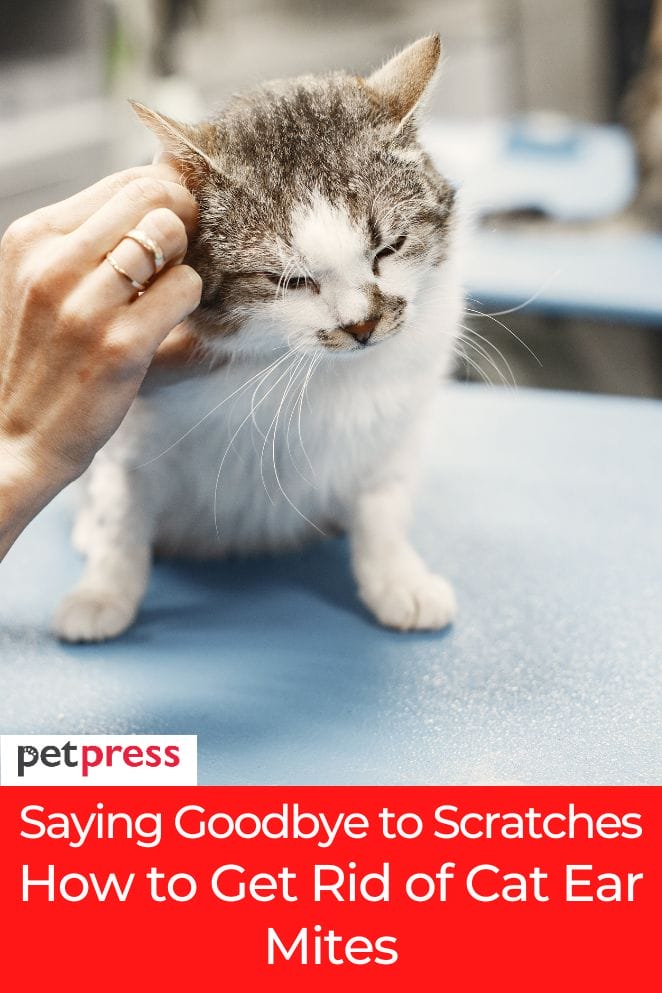
If you’ve noticed your cat scratching its ears more than usual or shaking its head frequently, it might be dealing with ear mites.
These tiny parasites can cause significant discomfort and, if left untreated, lead to serious health issues.
In this comprehensive guide, we’ll explore how to identify, treat, and prevent ear mites in cats, ensuring your furry friend remains happy and healthy.
Symptoms of Ear Mites
Recognizing the signs of ear mites early on can help you take prompt action.
Here are the common symptoms to look out for:
Scratching and head-shaking
If your cat is scratching its ears a lot or shaking its head frequently, it might have ear mites.
These mites cause intense itching, and your cat’s natural response is to try to scratch or shake them away.
Imagine having an itch you can’t reach—it’s frustrating and uncomfortable, which is why your cat may be constantly scratching or shaking its head.
Dark discharge
One of the hallmark signs of ear mites is a dark brown or black discharge in the cat’s ears.
This discharge often looks like coffee grounds. It’s a mixture of earwax, dried blood, and the mites themselves.
If you notice this, it’s a good indication that your cat may have ear mites.
Inflammation and redness
Ear mites cause a lot of irritation inside the ear canal.
This can lead to inflammation and redness.
When you look inside your cat’s ears, you might see that the skin is red and swollen.
This inflammation is a direct result of the mites biting and burrowing into the ear canal.
Hair loss
Cats with ear mites often scratch their ears so much that they can cause hair loss around their ears.
The constant scratching and rubbing can damage the skin, leading to bald patches.
If you notice your cat losing hair around its ears, it could be a sign of ear mites.
Ear odor
An unpleasant odor coming from your cat’s ears is another symptom of ear mites.
This smell is usually due to the accumulation of the dark discharge and can be exacerbated by secondary infections.
If your cat’s ears smell bad, it’s a good idea to check for ear mites and consult your vet.

Diagnosis
If you think your cat might have ear mites, it’s important to get a proper diagnosis from a veterinarian.
Here’s what happens during a vet visit:
Physical examination
The vet will start by looking inside your cat’s ears using a tool called an otoscope.
This instrument has a light and a magnifying lens that helps the vet see clearly inside the ear.
They’re checking for signs of ear mites, like dark discharge, redness, or inflammation.
The vet will be gentle, but your cat might still feel a bit uncomfortable due to the irritation in its ears.
Microscopic examination
To confirm ear mites, the vet will take a small sample of the ear discharge using a swab.
This sample will be examined under a microscope.
By looking at it closely, the vet can spot the tiny mites, which are too small to see with the naked eye.
This step is important because ear mites can have similar symptoms to other ear problems, so it’s essential to make sure the diagnosis is correct.

Treatment
Once ear mites are confirmed in your cat, it’s important to start treatment right away to relieve their discomfort.
Here’s a detailed look at the steps involved in treating ear mites:
Veterinary care
As soon as you suspect ear mites, consult your veterinarian.
They will prescribe the best medication tailored to your cat’s specific needs.
Professional guidance ensures your cat gets the right treatment.
Cleaning the ears
Before starting treatment, it’s important to gently clean your cat’s ears to remove as much ear discharge, mites, and eggs as possible.
Use a veterinary-recommended ear cleaner for this task.
Avoid using home remedies like coconut or olive oil, as these can harm the sensitive ear canal.
Your vet can demonstrate the proper cleaning method to avoid further irritation.
Medications
Your vet may prescribe topical ear medications that contain antibiotics, antifungal agents, and steroids.
These medications help treat any secondary infections and reduce inflammation in the ear, effectively killing the mites and easing your cat’s symptoms.
Systemic treatments
Some cases require systemic medications, which treat the entire body.
These include options like moxidectin or selamectin (macrocyclic lactones) and afoxolaner or fluralaner (isoxazolines).
These can be given as spot-on solutions or oral treatments, killing mites throughout the body for comprehensive relief.
Holistic treatments
Alongside conventional treatments, holistic remedies can support your cat’s recovery.
Supplements like probiotics, Omega-3 fatty acids, and vitamin C can help boost your cat’s immune system, improving overall health and resistance to infections.
Always consult your vet before starting any supplements to ensure they’re safe for your cat.

Prevention and Aftercare
Preventing ear mites and providing thorough aftercare is essential to keep your cat healthy and avoid re-infestation.
Here’s how to do it:
House cleaning
To prevent ear mites from returning, clean your home thoroughly, especially areas your cat frequents.
This includes their bed, the couch, and any favorite spots.
Vacuuming and washing these areas will help remove any mites that might still be around.
Ear mites can survive in the environment for a while, so a good cleaning is crucial.
Bathing
Bathing your cat can help eliminate mites that may have spread to other parts of their body.
Focus on washing the head, neck, and ears.
Use a gentle, pet-safe shampoo recommended by your vet.
This ensures the shampoo is effective against mites but safe for your cat’s sensitive skin.
Follow-up appointments
After the initial treatment, schedule follow-up appointments with your vet about two to three weeks later.
This is to make sure all the mites are gone.
Sometimes, a second round of treatment is needed to get rid of any remaining mites.
Your vet will check your cat’s ears and let you know if additional treatment is necessary.
Separation
If you have other pets, keep your cat separated during the treatment period.
Ear mites are highly contagious and can easily spread to other animals in your household.
By keeping your cat isolated, you can prevent the mites from spreading and protect your other pets.

Home Remedies
While veterinary treatment is the most effective way to deal with ear mites in cats, some home remedies can help manage the situation.
It’s important to use these remedies cautiously and ideally in consultation with your veterinarian to ensure they are safe for your cat.
Warm water and vinegar
One home remedy involves using a mixture of warm water and vinegar to clean your cat’s ears.
Here’s how it works:
- Preparation: Mix equal parts of warm water and vinegar. The vinegar helps to remove debris and mites because of its acidic properties.
- Application: Use a cotton ball or a soft cloth dipped in the solution to gently clean the inside of your cat’s ears. Be careful not to go too deep into the ear canal.
- Frequency: Clean the ears once a day, but avoid over-cleaning, as this can irritate your cat’s sensitive ear canal.
Mineral oil
Another method is to use mineral oil, which can help suffocate the mites. Here’s how you can do it:
- Preparation: Use a clean dropper or a small syringe to apply a few drops of mineral oil into your cat’s ear canal.
- Application: Gently massage the base of your cat’s ear to help the oil spread. The oil works by coating and suffocating the mites.
- Frequency: This treatment needs to be repeated regularly, usually once a day for several weeks. However, be cautious as overuse can cause trauma to the ear and leave an oily residue.
Important considerations
Consult your vet
Before trying any home remedy, it’s crucial to talk to your veterinarian.
They can provide guidance on whether the remedy is safe and suitable for your cat’s specific situation.
Veterinarians have the expertise to recommend the best treatments and ensure they won’t harm your cat’s ears or overall health.
Monitor for reactions
While using home remedies, keep a close watch on your cat for any signs of negative reactions.
These could include increased irritation, discomfort, or unusual behavior.
If you notice any of these reactions, stop the treatment immediately and contact your vet right away.
They can assess the situation and recommend appropriate next steps to ensure your cat’s well-being.

Conclusion
Ear mites can cause significant discomfort and health issues for your cat, but with prompt diagnosis and proper treatment, you can effectively manage and eliminate these parasites.
Regular cleaning, veterinary care, and preventive measures are key to keeping your cat’s ears healthy and mite-free.
FAQs
Ear mites primarily affect animals, but in rare cases, they can cause mild skin irritation in humans.
Treatment usually takes a few weeks. It’s essential to follow your veterinarian’s instructions and complete the full course of treatment.
If left untreated, ear mites can cause severe infections and potentially lead to hearing loss. Prompt treatment is crucial to prevent long-term damage.
Over-the-counter treatments are available but may not be as effective as those prescribed by a veterinarian. It’s best to consult your vet for the most appropriate treatment for your cat.
- Can You Have a Meerkat as a Pet? Everything You Need to Know - November 25, 2025
- Emerald Tree Skink: Your Complete Guide to This Stunning Lizard - November 24, 2025
- How Much Are Ragdoll Cats? A Complete Guide - November 21, 2025


GIPHY App Key not set. Please check settings